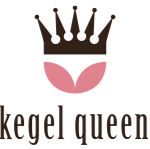
Women often ask me about rectal prolapse: do kegels help? There are two types of rectal prolapse, and the answer is different for each one.
First, let’s look at some definitions.
The rectum is part of your large intestine. It’s the last part of the large intestine that feces (a.k.a. poop) moves through before it gets to the anus. The anus is the opening. I’ve noticed that people seem to really hate using the word “anus,” so they often refer to the anus (the opening) incorrectly as the rectum.
Prolapse means that part of the body has shifted, or literally fallen, out of its normal position.
Two Kinds of Rectal Prolapse
The rectum can prolapse in two different ways: vaginally or anally.
Vaginal rectal prolapse is called rectocele. With a rectocele, the rectum has prolapsed so that it protrudes into the rear wall of the vagina. The rectum, covered by the vaginal wall, creates a bulge in the vagina. Depending on how severe a rectocele is, the bulge can be invisible inside the vagina, or extend down to the opening of the vagina, or if it’s severe, it can protrude out from the vaginal opening.
Anal rectal prolapse is sometimes, confusingly, referred to simply as “rectal prolapse.” For the sake of clarity, we’ll call it anal prolapse. With anal prolapse, the rectum itself turns inside-out and protrudes out from the anus.
Can Kegel Exercises Help?
Kegel exercises are exercises for the pelvic floor. The pelvic floor is a bowl of muscle that helps to support the pelvic organs, one of which is the rectum.
Can kegels help with rectocele? Yes. There’s research evidence showing that kegels can improve all types of vaginal prolapse, and many women in the Kegel Queen Program have seen improvement with rectocele. You can see some of their stories here.
Can kegels help with anal prolapse? Maybe. There’s no clear data one way or the other, either from research studies, or from the very few Kegel Queen members who have talked with me about this condition.
It’s possible that kegels could help with anal prolapse by increasing strength and muscle tone in the anal sphincter. The anal sphincter is part of the pelvic floor, and it’s among the muscles that get worked out when you do kegels correctly. The anal sphincter’s job is to keep the anus closed most of the time, and to open only when you want it open (to let out gas or poo). If you have anal prolapse, a malfunctioning anal sphincter might be contributing to the problem, although the root of the problem is the failure of other structures that hold the rectum itself in place.
If you suffer with anal prolapse and you decide to try the Kegel Queen Program, please stay in touch with me and share your results.
What Else Can I Do?
If you have rectocele, my webinar shares tips and strategies for how to care for all types of vaginal prolapse without surgery. It also shows you how to do one perfect kegel, the first step to doing kegels right.
If you have anal rectal prolapse, what can you try besides kegels? Acupuncture could help. You can also try Arvigo Therapy — speak with a practitioner in your area.
If you have either rectocele or anal prolapse, there’s one strategy that is absolutely, totally, and completely essential: prevent constipation.
Constipation, and the hard pushing that goes with it, could be a major reason you’re suffering with rectocele or anal prolapse now. If you want to stop your prolapse from getting worse, and give your body a chance to heal, you must avoid constipation at all costs.
You’re probably aware of the standard advice for preventing constipation, and it’s great advice: drink plenty of fluids, eat plenty of fiber, exercise. What you might not know is to pay attention to two key elements of gut health — food intolerance, and gut flora.
Gut flora, a.k.a. the gut biome, is the living colony of bacteria living in your digestive tract. Your gut flora can have a huge impact on how regularly and easily your bowels move. Healthy gut flora is not only about using probiotics (such as the acidophilus bacteria in yogurt), it’s about eating in a way that supports healthy flora. Details are beyond the scope of this post, but get your internet-searching game on and get some info! Here’s a sneak preview: eat a lot of vegetables.
Food intolerance is another often-overlooked cause of constipation. There may be certain foods that don’t trigger constipation for everyone, but do trigger it for you. Keep a journal that lists what you eat and when your constipation flares up, and see if you can find a connection. Or take a more proactive approach and try a short-term exclusion diet. You completely avoid certain foods for a while and see how your body responds as you add them back into your diet; it’s a great way to discover how specific foods are affecting your body.
One More Tip
If you suffer from rectal prolapse — either rectocele or anal prolapse — please take care of yourself emotionally. You may feel terrified, as if your body has gone out of control, or as if you’ll never feel confident, attractive, or even normal, again. It’s important to get emotional support from a trusted friend or counselor, so you take care of the emotional aspects of prolapse while you’re taking steps to heal physically.

